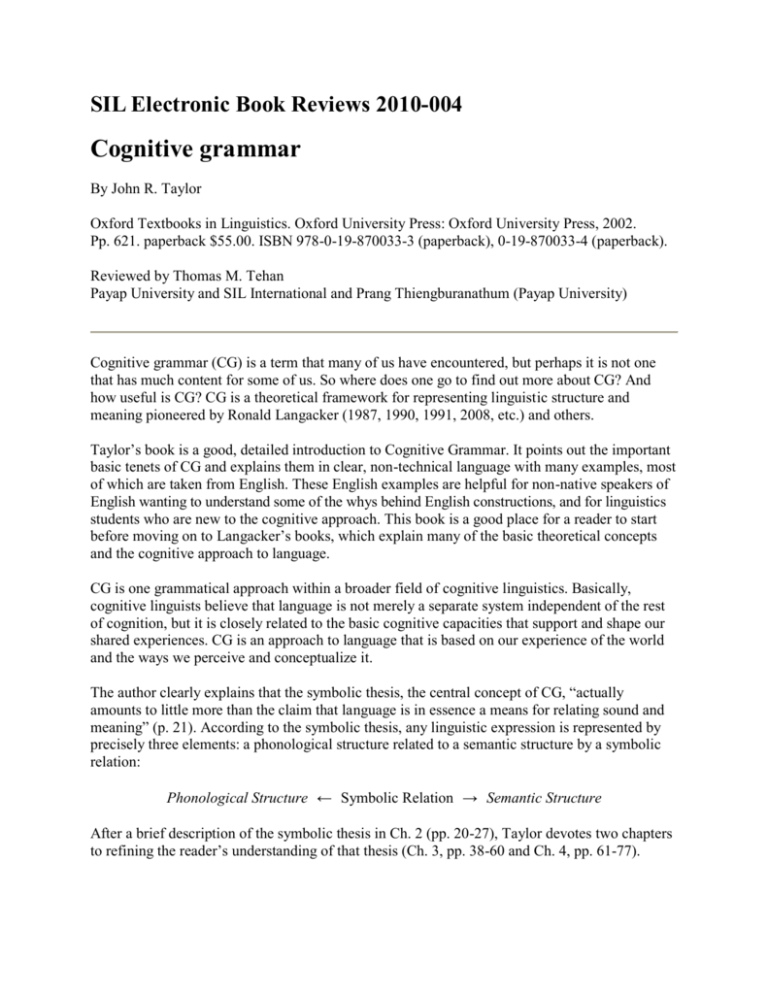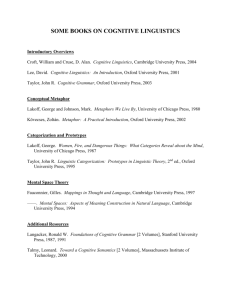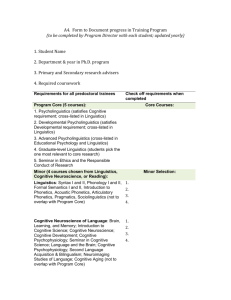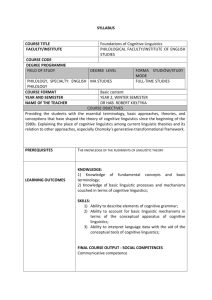
SIL Electronic Book Reviews 2010-004
Cognitive grammar
By John R. Taylor
Oxford Textbooks in Linguistics. Oxford University Press: Oxford University Press, 2002.
Pp. 621. paperback $55.00. ISBN 978-0-19-870033-3 (paperback), 0-19-870033-4 (paperback).
Reviewed by Thomas M. Tehan
Payap University and SIL International and Prang Thiengburanathum (Payap University)
Cognitive grammar (CG) is a term that many of us have encountered, but perhaps it is not one
that has much content for some of us. So where does one go to find out more about CG? And
how useful is CG? CG is a theoretical framework for representing linguistic structure and
meaning pioneered by Ronald Langacker (1987, 1990, 1991, 2008, etc.) and others.
Taylor’s book is a good, detailed introduction to Cognitive Grammar. It points out the important
basic tenets of CG and explains them in clear, non-technical language with many examples, most
of which are taken from English. These English examples are helpful for non-native speakers of
English wanting to understand some of the whys behind English constructions, and for linguistics
students who are new to the cognitive approach. This book is a good place for a reader to start
before moving on to Langacker’s books, which explain many of the basic theoretical concepts
and the cognitive approach to language.
CG is one grammatical approach within a broader field of cognitive linguistics. Basically,
cognitive linguists believe that language is not merely a separate system independent of the rest
of cognition, but it is closely related to the basic cognitive capacities that support and shape our
shared experiences. CG is an approach to language that is based on our experience of the world
and the ways we perceive and conceptualize it.
The author clearly explains that the symbolic thesis, the central concept of CG, “actually
amounts to little more than the claim that language is in essence a means for relating sound and
meaning” (p. 21). According to the symbolic thesis, any linguistic expression is represented by
precisely three elements: a phonological structure related to a semantic structure by a symbolic
relation:
Phonological Structure ← Symbolic Relation → Semantic Structure
After a brief description of the symbolic thesis in Ch. 2 (pp. 20-27), Taylor devotes two chapters
to refining the reader’s understanding of that thesis (Ch. 3, pp. 38-60 and Ch. 4, pp. 61-77).
Language, from a CG perspective, allows conceptualizations to be symbolized by means of
sounds (and gestures). Language is inherently symbolic. It is this symbolic system, the means of
human communication, that allows us to communicate our thoughts to others and to ourselves.
Grammar, as one facet of language, is itself inherently symbolic and is therefore meaningful as
well. The cognitive approach thus postulates a Grammar that has no autonomous existence at all,
and it is inseparable from meaning. This approach gives us an alternate way to go beyond a mere
description of the linguistic facts and to arrive at a more insightful explanation of the facts.
This book is formatted well and includes illustrations and diagrams which help the reader to
visualize and digest abstract cognitive notions. The contents are organized into seven parts. The
author clearly explains his purpose for each part. Part 1 is related to methodological issues. Part 2
provides basic concepts. Morphology is discussed in Part 3. Part 4 is about grammatical
categories: nouns, verbs, and clauses. Approaches to meaning are addressed in Part 5. Approaches
to metaphor and idioms are dealt with in Part 6 and constructions in Part 7. The reader, therefore,
can easily go straight to any topic of interest. Indexes of Names (4 pages) and Subjects (Topics)
(5 pages) are helpful in this regard too.
One slight problem with the book is that some issues are introduced in a cursory manner early on
in the discussion, but then need to be developed later in the book. The author, however, often just
mentions that a given issue will become clearer in due course. It would be helpful if references
were provided for where the topic development would be continued. For instance, ‘pragmatic
aspects of meaning’ is introduced in a discussion on semantic structure on page 21; later
pragmatics is distinguished from semantics on page 30. (See discussion below.) Pragmatics can
be found in the index. However, a footnote at the earlier instance could be helpful here instead of
asking the reader to just wait or to thumb her way through the indexes.
Helpful study questions are found at the end of each chapter. The author, however, does not
include answers to most of the questions, since they are intended as suggestions for further
investigation. (Answers to three study questions are found in the Appendix). Still, it would be
helpful if the reader could find at least some guidelines to evaluate her responses to the Study
Questions; perhaps suggested answers and further thoughts could be made available on the
internet. (By the way, many additional resources can be identified by searching for ‘Cognitive
Grammar John R. Taylor’ on the internet, although I couldn’t find a site that had suggested
answers for Taylor’s study questions.)
The book contains informative discussions on classification hierarchies, prototypes, ambiguity,
mental spaces, and many issues associated with verbs and verb phrases, among many other
interesting topics discussed in the book. Also attention should be drawn to the last few chapters,
which include a worthwhile debate about George Lakoff’s theories on metaphor and discussion
of some criticism and development by other CG researchers.
Another interesting topic that Taylor develops is pragmatics. The semantic focus of CG is
obvious throughout the book. But what is pragmatics from a CG standpoint? After stating that
CG blurs many traditional distinctions in linguistics (e.g. syntax vs. morphology, lexicon vs.
syntax-morphology), Taylor elaborates:
“Another distinction that gets blurred is that between semantics and pragmatics. Semantics is
traditionally concerned with the linguistically determined meaning of an expression, pragmatics
with the contextually conditioned interpretation of an expression. Pragmatic aspects can,
however, be incorporated into the conventionalized meaning of an expression. Because
conventionalization is a matter of degree, the distinction is a graded one, with no clear cut-off
point between the entrenched [i.e. conventionalized] meaning of an expression and its contextdependent interpretation” (p. 30).
CG concepts can lead to examining many aspects of linguistic investigation. Because of my
interest in Discourse (Textual) Analysis (DA), I asked myself how CG can help me gain some
insights into DA Trying to utilize all of CG and investigate all of DA is too much to tackle at this
time. So I would like to develop a few thoughts about the connections that come mind when CG
is used to examine at some elements that DA deals with regularly: Segmentation (Boundaries,
Internal Unity), Cohesion/Coherence, Genre/Typology, and Storyline/Salience scheme.
Segmentation (Boundaries, Internal Unity): This general area of investigation seems perhaps the
easiest to relate to the breadth of CG theory. In experiencing a discourse, the audience encounters a
series of markers that allows them to tie together things (events, concepts, etc.) that should go
together, and identify boundaries between minor or major segments. A phonological input is
taken in context as a signal, e.g. English also, then, the next time, and that signal activates
symbolic schemas in the audience’s brain. For instance, at the beginning of a sentence, also often
indicates that the next item goes with the previous one. All of the past encounters with also have
helped to shape the semantic structure (schema) associated with also. The whole schema in our
brain includes not only sentence syntax and semantic association, but also discourse-oriented
associations allowing the audience to group together elements and build the flow of the discourse.
Cognitive linguistics’ emphasis on the encyclopedic aspects of semantic structural knowledge
reminds us that narrow definitions will under-represent what we have associated with the
phonological shape represented by also, and other discourse markers.
Cohesion: Cohesive elements, which have overt phonological expression, also naturally fall into
this same area. Many connectors that are boundary markers and signals of internal unity can also
be discussed from the perspective of cohesive elements.
Coherence: However, underlying coherence (sometimes viewed as the deep structure that
represents the flow of a discourse) seems a little less straightforward. For instance, imagine a
story about a person who goes into a grocery store to buy things. As soon as the audience
recognizes what is happening, then a ‘going to a store and buying things’ script (semantic
structure) is activated and helps to tie a segment together. We expect the person to enter the
store, walk among the merchandise, examine and select items, proceed to a check-out counter,
pay for the items selected, and finally leave the store. So in cognitive linguistics terms, how does
this script get activated? To be consistent with CG theory, it must be hung on some phonological
structure? If so what? Could it all connected to a grocery store schema? I know it must be
attached to certain neurons that are networked together in the brain, and these get activated. But
that is not a Phonological Structure. Is the grocery store schema activated when the words store
and shop are heard? I haven’t sorted this out yet, but I’m still not comfortable connecting
coherence in texts to Phonological Structures.
Genre/Typology: Similarly how can CG help me to understand the issues associated with the
type of discourse I am encountering. The symbolic thesis would propose that if I have a semantic
discourse structure in my brain (e.g. fairy tales begin with ‘once upon a time’ and have many
more encyclopedic associated elements such as witches, forests, patterns of three, talking
animals, etc.), then it is in relationship with a brain-stored phonological pattern, perhaps ‘once
upon a time’. When ‘once upon a time’ is actually spoken and processed in my mind, then the
whole fairy tale schema is awoken and I have the expectations associated with the fairy tale
genre. So an entire discourse is a linguistic expression of what? A genre, perhaps.
CG concepts suggest thinking of a genre as a semantic schema that is stored as a prototype, a set
of characteristics that strongly or weakly apply. If I have a general semantic structure in my brain
for fairy tale, then it can be activated by actually encountering a fairy tale discourse. This actual
discourse that is produced would then be an instance of the fairy tale genre prototype (see page
74 and chapter 7). As we encounter the instance, then the fairy tale schema is activated and all of
the associations associated with the schema are there for the story teller to hook into. So an entire
discourse is a linguistic instantiation of perhaps a genre. A set of characteristics organized
around a prototype. The fairy tale genre could be activated when certain sounds are said, e.g.
“once upon a time” or “this is a fairy tale” or “once there was a man who.” But I still puzzle
about what Phonological Structure this schema is related to, because we can recognize a fairy
tale without any of these prototypical introductory phrases.
Storyline: Concepts associated with Storyline are hard for me to put into certain aspects of CG
and easy for other aspects. For instance, in English narrative we would have a prototype that the
main events of a story would be expressed in a series of volitional actions encoded by simple
past verbs. Imagine a very short narrative: “Bill went, he saw, he ate (while looking around), and
then he left.” Each italicized clause would be on the main storyline. So that would be an
instantiation of the narrative prototype. But is there a phonological structure that it is tied to? Not
one that I can imagine. I could tie it to ‘once upon a time’, but that would only give me fairy-tale
storyline. I couldn’t tie it to then because all storylines don’t use the word then. I don’t see how I
can tie it to grammatical English past tense, because it certainly does not have one phonological
shape. This is another example of my gaining insights from CG but not being able to answer
some basic questions.
There’s much more to explore about DA: salience scheme, participant analysis, conversation
analysis, quotations, embedded discourses, prominence, information management—the topics
are endless. You’ll just have to explore those for yourself as you work your way through
Cognitive Grammar and apply the concepts and techniques to the aspects of language you know
most about.
There is no doubt this is an excellent book for a student of linguistics (whether mother-tongue
speaker of English or not) to study for insights into both language and Cognitive Linguistics. The
book provides enough practical detail to allow the reader to develop a good description of any
language, and the book is comprehensive enough that it could be used in courses introducing
grammatical analysis or Cognitive Grammar.
References
Croft, William, and D. Alan Cruse. 2004. Cognitive linguistics. Cambridge Textbooks in
Linguistics. Cambridge: Cambridge University Press.
Dirven, Rene and Marjolijn Verspoor, eds. 1998. Cognitive exploration of language and
linguistics. Philadelphia: John Benjamins Publishing Company
Evans, Vyvyan, and Melanie Green. 2006. Cognitive linguistics: An introduction. Mawhaw,
N.J.: Erlbaum.
Evans, Vyvyan, Benjamin K. Bergen, and Jorg Zinken (eds.) 2006. The Cognitive Linguistics
Reader. London: Equinox.
Geeraerts, Dirk. (ed.) 2006. Cognitive linguistics: Basic readings. Cognitive Linguistics
Research 34. Berlin: Mouton de Gruyter.
Langacker, Ronald W. 1987, 1999. Foundations of cognitive grammar: Theoretical
prerequisites, Vol. 1. Stanford, CA: Stanford University Press.
Langacker, Ronald W. 1990. Foundations of cognitive grammar: Descriptive application, Vol. 2.
Stanford, CA: Stanford University Press.
Langacker, Ronald W. 1991. Concept, image and symbol: The cognitive basis of grammar.
Berlin: Mouton/De Gruyer,
Langacker, Ronald W. 2008. Cognitive grammar: A basic introduction. Oxford: Oxford
University Press.
Lee, David. 2001. Cognitive linguistics: An introduction. New York: Oxford University Press.
Ungerer, Friedrich, and Hans-Jörg Schrnid. 2007. An introduction to cognitive linguistics. 2nd
ed. London: Pearson Longman.








